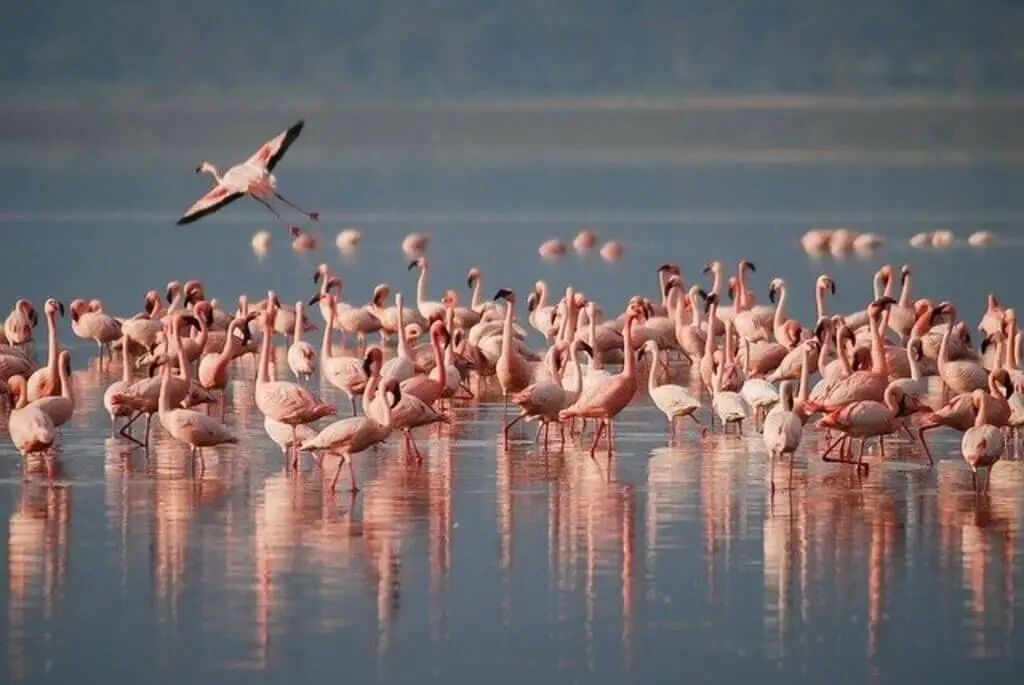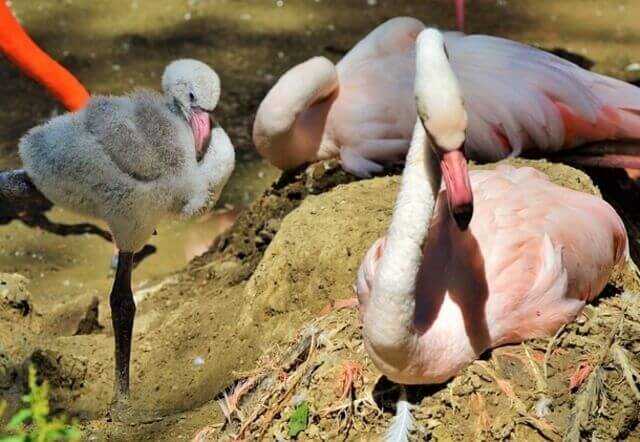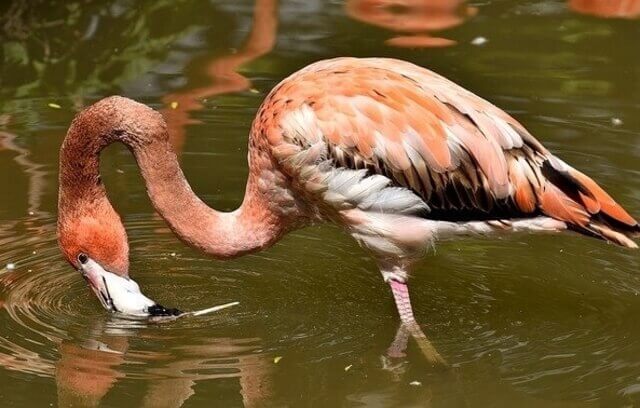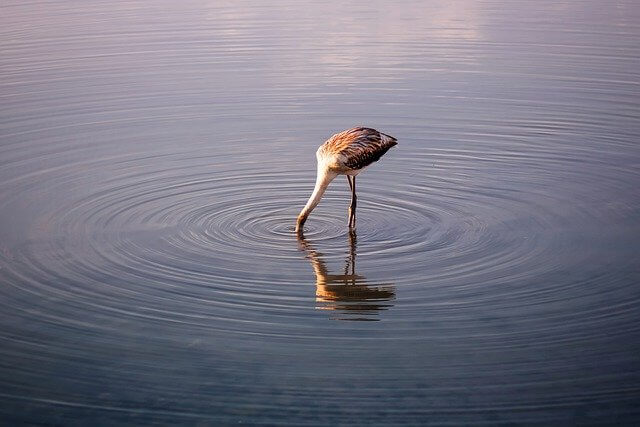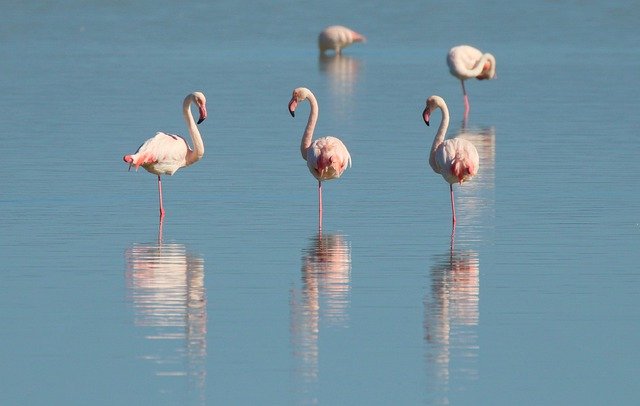Flamingos are one of the most recognizable and beloved birds in the world. With their vibrant pink feathers, long necks, and distinctive bills, these birds are a true sight to behold. But there is much more to these fascinating creatures than meets the eye.
In this article, we will explore 25 fascinating facts about flamingos, from their unique physical adaptations to their social behavior and more. So, whether you’re a bird enthusiast or simply curious about these beautiful animals, read on to discover some amazing facts about flamingos!
Table of Contents
- 1 Key Takeaways
- 2 Facts About Flamingos
- 2.1 Flamingo Social Behavior
- 2.2 Dietary Adaptations
- 2.3 Filter-Feeding Mechanism
- 2.4 Dynamic Range of Flamingo Species
- 2.5 Impressive Flying Abilities
- 2.6 Complex Reproductive Rituals
- 2.7 Global Distribution
- 2.8 Conservation Challenges
- 2.9 Flamingos and Human Culture
- 2.10 Research and Scientific Insights
- 2.11 Physiological Adaptations
- 2.12 Flamingo Vocalizations
- 2.13 Flamingo Nesting Behavior
- 2.14 Flamingo Egg Care
- 2.15 Feeding Strategies
- 2.16 Flamingo Senses
- 2.17 Conservation Success Stories
- 2.18 Role in Ecosystems
- 2.19 Longevity and Life Cycle
- 2.20 Flamingos in Captivity
- 2.21 Molting and Feather Health
- 2.22 Flamingos and Thermoregulation
- 2.23 Social Hierarchy and Courtship Displays
- 2.24 Adaptations for High-Salinity Environments
- 2.25 Conservation Challenges
- 3 Author
Key Takeaways
- Flamingo Pink Coloration: Flamingos’ signature pink color comes from pigments called carotenoids, primarily obtained through their diet of shrimp and crustaceans.
- Molting and Feather Health: Molting is a vital process for flamingos, allowing them to shed and replace feathers, ensuring insulation and waterproofing.
- Thermoregulation: Flamingos use their pink coloration to manage body temperature, with darker feathers absorbing more heat and lighter feathers reflecting sunlight.
- Social Hierarchy and Courtship: These highly social birds live in large colonies and establish hierarchies based on age and size. Courtship displays, including synchronized marching and mutual preening, strengthen pair bonds.
- Adaptations to Saline Environments: Flamingos in hypersaline environments possess specialized salt glands near their eyes to excrete excess salt and thrive on brine shrimp and algae.
- Conservation Challenges: Flamingos face threats like habitat loss, disturbance at breeding sites, and water pollution. Conservation efforts, habitat restoration, and strict regulations are crucial for their survival.
Facts About Flamingos
Flamingo Social Behavior
Flamingos are renowned for their strong social tendencies. They live in large colonies, often comprising thousands of individuals. These colonies serve various purposes, including protection from predators and the sharing of vital resources. In these colonies, flamingos engage in complex social interactions, from synchronized courtship displays to collective feeding efforts. Their strong social bonds help ensure their survival in challenging wetland environments.
Dietary Adaptations
Flamingos possess specialized adaptations for their unique diet. Their signature pink coloration arises from the presence of carotenoid pigments in their food, primarily shrimp and other crustaceans. These pigments are absorbed by their bodies and deposited in their feathers, skin, and beaks, resulting in their vibrant pink hue. Beyond their iconic color, carotenoids also provide antioxidants that aid in their overall health.
Filter-Feeding Mechanism
Flamingos are filter feeders, using their distinctive bills to extract tiny aquatic organisms from the water. The serrated edges of their bills help filter out small organisms while allowing water to pass through. This feeding method enables them to efficiently capture zooplankton, algae, and small invertebrates. Their specialized tongues, equipped with hair-like structures called lamellae, further aid in trapping and swallowing their prey. This adaptation allows them to exploit the rich food resources found in their aquatic habitats.
Dynamic Range of Flamingo Species
Flamingos are a diverse group of birds, with six recognized species worldwide. While the Greater flamingo is perhaps the most well-known, others like the American flamingo, Lesser flamingo, Chilean flamingo, James’s flamingo and Andean flamingo exhibit unique characteristics. For instance, the Andean flamingo boasts distinct coloration, including yellow legs and a striking combination of white, pink, and yellow feathers. These species have adapted to various habitats, ranging from saline lakes to high-altitude plateaus, showcasing their remarkable versatility.
Impressive Flying Abilities
Flamingos are not just graceful waders; they are also skilled flyers. They possess long wings that enable them to take to the air with grace. During flights, flamingos can reach impressive speeds, with some species capable of flying at up to 35 mph on short trips and up to 40 mph on long trips with a tailwind. Their powerful flight muscles allow them to cover considerable distances in search of suitable breeding grounds and feeding areas. These journeys are vital for their survival, as they rely on the availability of specific habitats for both breeding and feeding.
Complex Reproductive Rituals
Breeding among flamingos involves intricate rituals that strengthen pair bonds and facilitate successful reproduction. During courtship displays, flamingos engage in synchronized dancing, where large groups move in unison, creating mesmerizing patterns. These displays are accompanied by vocalizations, which further reinforce social connections. After forming pairs, flamingos build cone-shaped mud nests in shallow waters. Both male and female take turns incubating the eggs, showcasing cooperative parenting. These behaviors are crucial for ensuring the survival of their chicks in the challenging wetland environments they call home.
Global Distribution
Flamingos are remarkably widespread, with their populations distributed across almost every continent. They inhabit diverse wetland ecosystems, from the Americas to Africa, Europe, and Asia. While some species, like the American flamingo, are primarily found in the Western Hemisphere, others, such as the greater flamingo, have a more extensive range, spanning multiple continents. Their adaptability to different wetland types, from coastal salt flats to high-altitude lakes, highlights their resilience and ability to thrive in various environments.
Conservation Challenges
Flamingos face numerous conservation challenges due to habitat loss, pollution, and disturbances in their breeding areas. Human activities, such as wetland drainage and urban development, threaten their fragile habitats. Additionally, pollution from agricultural runoff and industrial processes can contaminate their feeding areas. Conservation organizations around the world are dedicated to protecting these magnificent birds and the vital wetlands they rely on. Efforts include habitat restoration, monitoring of breeding colonies, and raising awareness about the importance of preserving these unique ecosystems.
Flamingos and Human Culture
Flamingos have left an indelible mark on human culture and symbolism. Their distinctive appearance and vibrant plumage have made them popular subjects in art, literature, and folklore. They are often associated with grace, elegance, and tropical paradises. Flamingos also hold religious significance in various cultures, symbolizing purity, rebirth, and resurrection. Their presence in wetland ecosystems serves as a symbol of the vitality and ecological richness of these habitats, reinforcing the importance of their conservation.
Research and Scientific Insights
Flamingos continue to captivate the interest of scientists and researchers who study their behavior, physiology, and ecological roles. Ongoing studies aim to unravel the mysteries of their long-distance migrations, breeding habits, and the intricate mechanisms behind their unique coloration. By gaining a deeper understanding of flamingos, researchers contribute valuable insights into wetland ecology and the broader conservation of these charismatic birds and their habitats.
Physiological Adaptations
Flamingos possess fascinating physiological adaptations that allow them to thrive in extreme environments. Their long legs and necks help them wade in deep waters while keeping their bodies dry. This anatomy enables them to access food sources that are beyond the reach of many other birds. Additionally, their webbed feet, often concealed beneath the water’s surface, provide stability and balance while foraging in soft, muddy substrates.
Flamingo Vocalizations
Flamingos are not just known for their striking appearance but also for their unique vocalizations. They communicate with a variety of sounds, including honks, grunts, and nasal calls. These vocalizations serve various purposes, from maintaining group cohesion to signaling danger or initiating courtship rituals. The synchronization of their calls during courtship displays creates a harmonious spectacle in their breeding colonies.
Flamingo Nesting Behavior
Flamingos exhibit fascinating nesting behaviors that are adapted to their watery habitats. They build nests in shallow waters using mud and other available materials. These nests are carefully crafted to protect their eggs from potential threats such as flooding. Flamingos engage in communal nesting, forming large colonies that provide added protection against predators and disturbances.
Flamingo Egg Care
Once flamingos lay their eggs in nests, both the male and female take on parenting responsibilities. They take turns incubating the eggs, with one bird incubating while the other feeds. This cooperative approach helps ensure the eggs are protected and receive the necessary warmth for successful development. Such shared parenting efforts are vital in the challenging and dynamic wetland environments where they nest.
Feeding Strategies
Flamingos have evolved remarkable feeding strategies to exploit the rich food sources in their habitats. Their distinctive bills are designed for filter feeding, but they can also use them to “pump” water in and out, aiding in the filtration process. By tilting their heads underwater and rapidly moving their bills, they create a flow of water that carries tiny prey into their mouths. This feeding method allows them to extract maximum nutrients from their food.
Flamingo Senses
Flamingos rely on their senses to navigate their surroundings and locate food. Their excellent eyesight helps them spot potential predators and prey in the water. They can see well both in daylight and low-light conditions. In addition to sight, flamingos possess a keen sense of touch, primarily through their sensitive bills, which helps them detect prey and assess water quality.
Conservation Success Stories
While some flamingo species face conservation challenges, others have seen remarkable recoveries. The Chilean flamingo, for instance, has benefited from conservation efforts in its breeding areas. By establishing protected areas and regulating human activities in critical wetland habitats, conservationists have helped stabilize populations. These success stories emphasize the importance of proactive conservation measures to safeguard these elegant birds.
Role in Ecosystems
Flamingos play a vital role in the ecosystems they inhabit. By feeding on algae, plankton, and small invertebrates, they help control nutrient levels in aquatic environments. Their foraging activities can influence water quality and even affect the distribution of prey species. As both predators and prey, they are integral components of wetland food webs, highlighting their significance in maintaining ecosystem balance.
Longevity and Life Cycle
Flamingos have relatively long lifespans in the wild, with some individuals reaching 20 to 30 years of age. Their life cycle encompasses several stages, from hatching and chick-rearing to forming breeding pairs and migrating. Learning about their life history provides insights into their resilience and adaptability in dynamic wetland ecosystems.
Flamingos in Captivity
Flamingos are popular attractions in zoos and aviaries worldwide. These captive environments help educate the public about the fascinating biology and behaviors of these birds. Conservation programs in captivity also contribute to the genetic diversity of flamingo populations and support ongoing efforts to protect their wild counterparts. Zoological institutions play a critical role in the conservation of these iconic birds.
Molting and Feather Health
Flamingos undergo a process called molting, during which they shed and replace their feathers. Molting is crucial for maintaining the health and functionality of their plumage. It helps them maintain their insulation and waterproofing, ensuring they can continue to thrive in their wetland habitats. Flamingos often molt in groups, which can create striking scenes of multicolored feathers floating on the water’s surface.
Flamingos and Thermoregulation
Living in a range of climates, flamingos face temperature fluctuations that demand effective thermoregulation. Their pink coloration, apart from being linked to diet, plays a role in temperature regulation. Darker feathers contain more pigments, which can absorb more heat from the sun, while lighter feathers reflect sunlight. Flamingos can adjust their posture, standing on one leg and tucking the other under their feathers, to minimize heat loss through their legs.
Social Hierarchy and Courtship Displays
Flamingos are highly social birds that live in large colonies. Within these colonies, they establish social hierarchies, often based on age and size. During the breeding season, their courtship displays become intricate and synchronized. These displays involve synchronized marching, head-flagging, and mutual preening. Courtship displays help strengthen pair bonds and maintain social cohesion within the colony.
Adaptations for High-Salinity Environments
Some flamingo species inhabit saline or hypersaline environments where few other creatures can thrive. Their specialized salt glands, located near their eyes, help excrete excess salt from their bodies. This adaptation enables them to extract nutrients from the brine shrimp and algae they feed on while minimizing the harmful effects of salt accumulation.
Conservation Challenges
Flamingos face various conservation challenges, including habitat loss, disturbance at breeding sites, and water pollution. Climate change can also affect the availability and quality of their wetland habitats. Conservation efforts are essential to protect these elegant birds and their fragile ecosystems. Collaborative initiatives, habitat restoration, and strict regulations on human activities in key flamingo habitats are critical steps toward securing their future.

